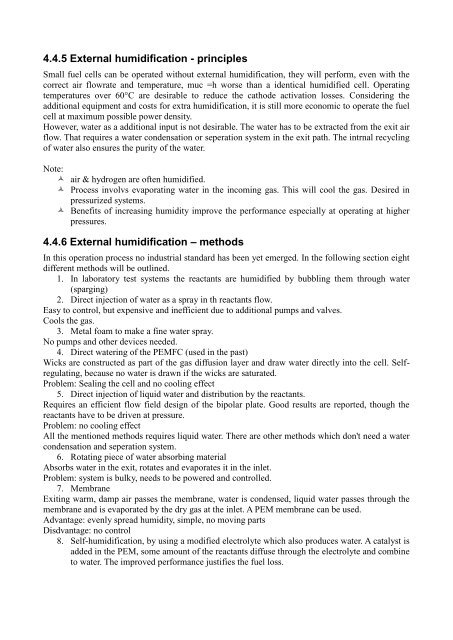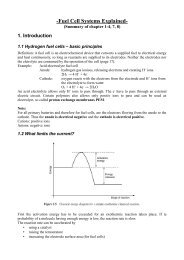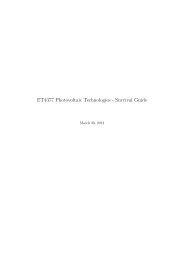Fuel Cell Systems Explained - from and for SET students
Fuel Cell Systems Explained - from and for SET students
Fuel Cell Systems Explained - from and for SET students
You also want an ePaper? Increase the reach of your titles
YUMPU automatically turns print PDFs into web optimized ePapers that Google loves.
4.4.5 External humidification - principlesSmall fuel cells can be operated without external humidification, they will per<strong>for</strong>m, even with thecorrect air flowrate <strong>and</strong> temperature, muc =h worse than a identical humidified cell. Operatingtemperatures over 60°C are desirable to reduce the cathode activation losses. Considering theadditional equipment <strong>and</strong> costs <strong>for</strong> extra humidification, it is still more economic to operate the fuelcell at maximum possible power density.However, water as a additional input is not desirable. The water has to be extracted <strong>from</strong> the exit airflow. That requires a water condensation or seperation system in the exit path. The intrnal recyclingof water also ensures the purity of the water.Note: air & hydrogen are often humidified. Process involvs evaporating water in the incoming gas. This will cool the gas. Desired inpressurized systems. Benefits of increasing humidity improve the per<strong>for</strong>mance especially at operating at higherpressures.4.4.6 External humidification – methodsIn this operation process no industrial st<strong>and</strong>ard has been yet emerged. In the following section eightdifferent methods will be outlined.1. In laboratory test systems the reactants are humidified by bubbling them through water(sparging)2. Direct injection of water as a spray in th reactants flow.Easy to control, but expensive <strong>and</strong> inefficient due to additional pumps <strong>and</strong> valves.Cools the gas.3. Metal foam to make a fine water spray.No pumps <strong>and</strong> other devices needed.4. Direct watering of the PEMFC (used in the past)Wicks are constructed as part of the gas diffusion layer <strong>and</strong> draw water directly into the cell. Selfregulating,because no water is drawn if the wicks are saturated.Problem: Sealing the cell <strong>and</strong> no cooling effect5. Direct injection of liquid water <strong>and</strong> distribution by the reactants.Requires an efficient flow field design of the bipolar plate. Good results are reported, though thereactants have to be driven at pressure.Problem: no cooling effectAll the mentioned methods requires liquid water. There are other methods which don't need a watercondensation <strong>and</strong> seperation system.6. Rotating piece of water absorbing materialAbsorbs water in the exit, rotates <strong>and</strong> evaporates it in the inlet.Problem: system is bulky, needs to be powered <strong>and</strong> controlled.7. MembraneExiting warm, damp air passes the membrane, water is condensed, liquid water passes through themembrane <strong>and</strong> is evaporated by the dry gas at the inlet. A PEM membrane can be used.Advantage: evenly spread humidity, simple, no moving partsDisdvantage: no control8. Self-humidification, by using a modified electrolyte which also produces water. A catalyst isadded in the PEM, some amount of the reactants diffuse through the electrolyte <strong>and</strong> combineto water. The improved per<strong>for</strong>mance justifies the fuel loss.






